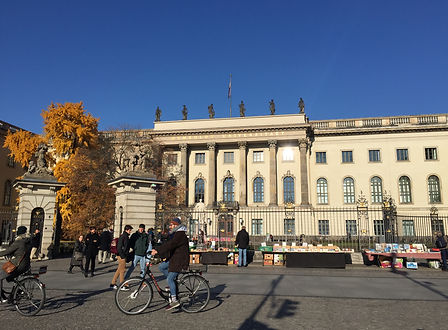
Bebelplatz

Bebelplatz is an installation to commemorate Kristallnacht, the night of the burning books which took place outside Humboldt University on 10th May 1933. The memorial has been designed by Micha Ullman, an Israeli installation artist and is composed of a square-shaped glass window fixed atop the cobbled ground. The window provides a subterranean view of white empty bookshelves with the capacity to store approximately 20,000 books. The empty shelves symbolise the events held in the square, burning books which were deemed ‘un-German’ by the Nazis in an attempt to purify Germany to create an Aryan race.
The monument is uniquely situated below ground and thus is easily missed by passers-by, demonstrating the everydayness about the counter-monument. The monument is not visible at first glance and is challenging to find in the square, this is often stumbled across suddenly facing people with the task of memory work and as an unexpected reminder of the tragic hatred that occurred at a site which currently is a thriving place of culture, in the middle of an opera house and outside Humboldt University.
BACKGROUND



It is exceedingly difficult to look at the memorial during daytime as the glass pane is reflexive so it mirrors the sky and the viewer’s reflection, hindering the sight of the bookshelves. The reflection of the aboveground landscape is a conscious element of the Bebelplatz memorial and is a deliberate use of geography and space. Uniquely, the present-day landscape juxtaposes the brutality of Nazi terror which occured at that site, and viewers are made to look at their own peering faces in stark contrast to the emptiness seen through the glass, thus innovatively exploring the geography of memory through the becoming a part of the installation.
At night the memorial is lit from the inside exuding a faint glow which can be seen around the site as a symbolic representation of a fire and the event of Kristallnacht. During the winter the light used in the memorial melts the snow on top of the glass square, thus is always visible.
The location of this site, outside Humbodlt University, is fiercely ironic as the destruction rational thinking and teaching occurred outside an institution of education. Students passing by and visitors at the University are struck with the monument as an unexpected symbol of oppression, the torture of censorship and not being allowed to learn or practice the Jewish way of life, which is inherently taught through books.
Moreover, across the road from the memorial, outside another building of Humboldt University there is a small market selling second hand books. This is a remarkable paradox to the events that occurred at the site 80 years ago. Although the small market is not an official monument, it is an effective memorial and a lucid example of the changing times and the development of Berlin being far removed from the errors of past generations.


Current memorial practices in Berlin not only try to preserve the memory of the event, but also question it and instigate critical reflection. Through this way of memorializing, the monument does not simply present or illustrate the past to a contemporary audience, but actively captures an understanding of the past in its form and figuration.
Bebelplatz memorial is entirely void of a narrative, with the exception of the empty bookshelves and the reflection of people peering into the glass window to the vacant underground room, and so allows visitors to form their own connection to commemorating the event that took place.
COMMEMORATIVE PLAQUE
Beside the memorial is a steel plaque stating that Bebelplatz was the site of the notorious book burnings during the Shoah and is engraved with the words of Heinrich Heine:
“Dort, wo man Bucher verbrennt, verbrennt man am Ende auch Menschen”
“Where they burn books, they eventually burn people”
This is a damning sentence reminding the current and future populations that destruction is a spiralling process, destroying inanimate objects eventually leading to the murder of the living. The memorial of empty shelves is a harrowing reminder of what was left from Kristallnacht and the censorship imposed by the Nazis. Ullman’s Bebelplatz memorial is a powerful way of effectively reminding people passing by of what happened less than a century ago, and what could have been.



